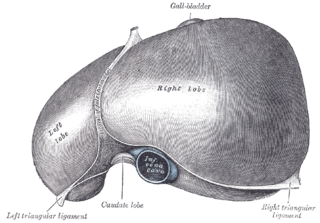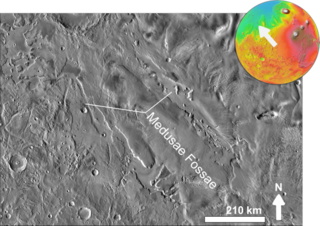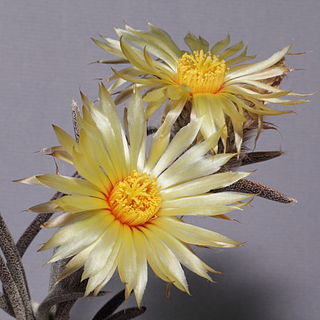This page is based on this
Wikipedia article Text is available under the
CC BY-SA 4.0 license; additional terms may apply.
Images, videos and audio are available under their respective licenses.

The umbilical vein is a vein present during fetal development that carries oxygenated blood from the placenta into the growing fetus. The umbilical vein provides convenient access to the central circulation of a neonate for restoration of blood volume and for administration of glucose and drugs.

Caput medusae is the appearance of distended and engorged superficial epigastric veins, which are seen radiating from the umbilicus across the abdomen. The name caput medusae originates from the apparent similarity to Medusa's head, which had venomous snakes in place of hair. It is also a sign of portal hypertension. It is caused by dilation of the paraumbilical veins, which carry oxygenated blood from mother to fetus in utero and normally close within one week of birth, becoming re-canalised due to portal hypertension caused by liver failure.
Caput Medusae is Latin for "head of Medusa". It may also refer to:
Ptychopyxis is a genus of plant of the family Euphorbiaceae first described in 1861. It is native to Southeast Asia and New Guinea.
- Ptychopyxis arborea - Borneo
- Ptychopyxis bacciformis - Vietnam, Borneo, Sumatra, Philippines, W Malaysia
- Ptychopyxis caput-medusae - W Malaysia
- Ptychopyxis chrysantha - New Guinea
- Ptychopyxis costata - Borneo, Sumatra, W Malaysia
- Ptychopyxis glochidiifolia - Sumatra, Sarawak, Brunei, Kalimantan Timur
- Ptychopyxis grandis - Borneo
- Ptychopyxis javanica - S Thailand, Vietnam, W Malaysia, Borneo, Sumatra, Java
- Ptychopyxis kingii - W Malaysia, E Sumatra, Sarawak, Sabah
- Ptychopyxis plagiocarpa - S Thailand, S Myanmar

Astrophytum is a genus of six species of cacti, native to North America.

The falciform ligament is a ligament that attaches the liver to the anterior (ventral) body wall, and separates the liver into the left medial lobe and left lateral lobe. The falciform ligament, from Latin, meaning 'sickle-shaped', is a broad and thin fold of peritoneum, its base being directed downward and backward and its apex upward and backward. The falciform ligament droops down from the hilum of the liver.

The round ligament of the liver is a degenerative string of tissue that exists in the free edge of the falciform ligament of the liver. The round ligament divides the left part of the liver into medial and lateral sections.
The thoracoepigastric vein runs along the lateral aspect of the trunk between the superficial epigastric vein below and the lateral thoracic vein above and establishes an important communication between the femoral vein and axillary vein. This is an especially important vein when the inferior vena cava (IVC) becomes obstructed, by providing a means of collateral venous return. It creates a cavocaval anastomosis by connecting with superficial epigastric veins arising from femoral vein just below inguinal ligament.
In the course of the round ligament of liver, small veins (paraumbilical) are found which establish an anastomosis between the veins of the anterior abdominal wall and the hepatic portal, hypogastric, and iliac veins.
A portacaval anastomosis is a specific type of anastomosis that occurs between the veins of the portal circulation and those of the systemic circulation.
The inferior end of the esophagus and the superior part of the rectum are potential sites of a harmful portacaval anastomosis.
Bulbine caput-medusae is a species of plant in the Asphodelaceae family. It is endemic to Namibia. Its natural habitats are dry savanna and hot deserts.

Tillandsia caput-medusae is a species of flowering plant in the bromeliad family, Bromeliaceae, subfamily Tillandsioideae. Common names include octopus plant and medusa's head. An epiphyte native to Central America and Mexico, T. caput-medusae is a commonly cultivated bromeliad species. The thick, channeled, tapering and twisting leaves are up to 25 cm (9.8 in) long and are covered in fine gray hairs. The rosette of leaves arise from an inflated pseudobulb. Pups are produced after blooming, as is usual with most Tillandsia species.

The Blue Oak Ranch Reserve, a unit of the University of California Natural Reserve System, is a ecological reserve and biological field station in Santa Clara County, California. It is located on 3,260 acres (13.2 km2) in the Diablo Range, northwest of Mount Hamilton, at 1,500 ft (460 m) elevation.

The Medusae Fossae Formation is a large geological unit of probable volcanic origin on the planet Mars. It is named for the Medusa of Greek mythology. "Fossae" is Latin for "trenches". Located roughly at 5°S 213°E, it straddles the highland - lowland boundary near the Tharsis and Elysium volcanic areas. The Medusae Fossae Formation lies partly in five quadrangles: the Amazonis quadrangle, the Tharsis quadrangle, the Memnonia quadrangle, the Elysium quadrangle, and the Aeolis quadrangle.

Taeniatherum is a genus of Eurasian and North African plants in the grass family known by the common name medusahead.

Hordelymus is a genus of European, north African, and southwest Asian plants in the grass family.

Urania's Mirror; or, a view of the Heavens is a set of 32 astronomical star chart cards, first published in November 1824. They had illustrations based on Alexander Jamieson's A Celestial Atlas, but the addition of holes punched in them allowed them to be held up to a light to see a depiction of the constellation's stars. They were engraved by Sidney Hall, and were said to be designed by "a lady", but have since been identified as the work of the Reverend Richard Rouse Bloxam, an assistant master at Rugby School.

Astrophytum caput-medusae is a species of cactus native to Mexico, specifically the state of Nuevo León; the plant is reported to grow wild only at a single location. This species differs from the conventional star-shaped phenotype associated with other Astrophytum members. The plant is characterized by a cylindrical, reduced stem with triangular or cylindrical tubercles producing yellow flowers with orange perianth sections. Propagation by seed, tissue culture or via grafting have all been reported. The species is considered critically endangered by the IUCN due to the plant's limited growth range, destruction by livestock and over collection of wild specimen by plant collectors

A developmental venous anomaly is a congenital variant of the cerebral venous drainage. On imaging it is seen as a number of small deep parenchymal veins converging toward a larger collecting vein.














